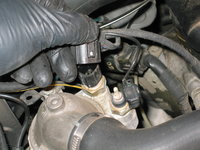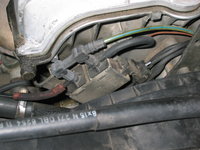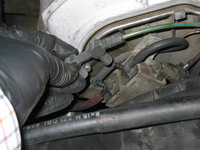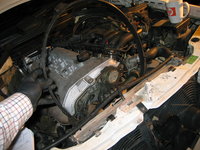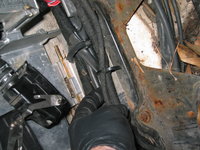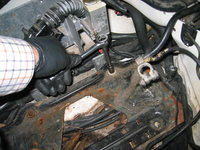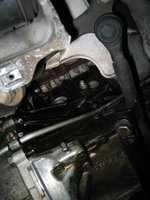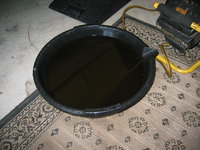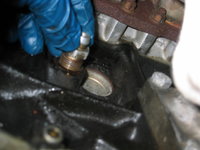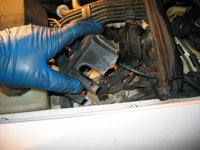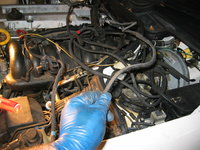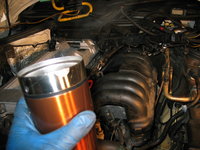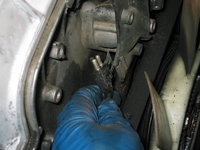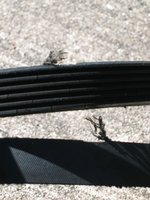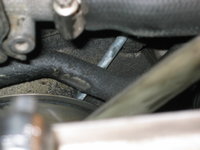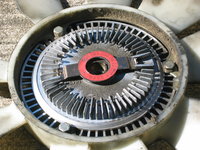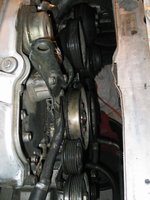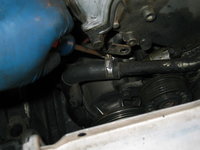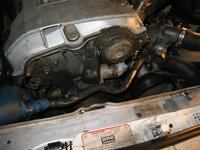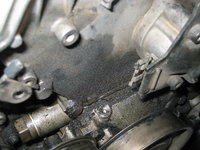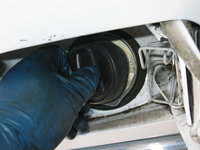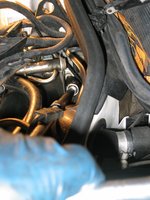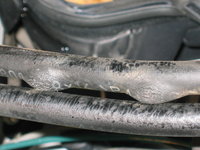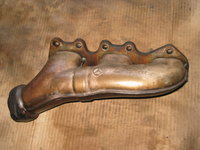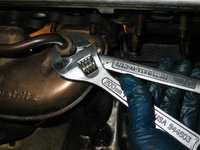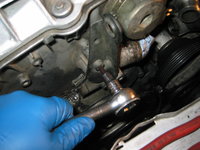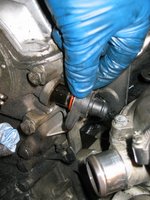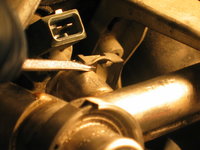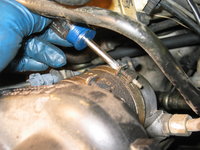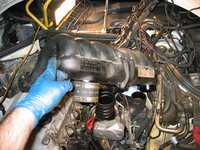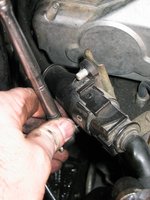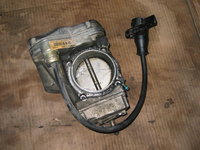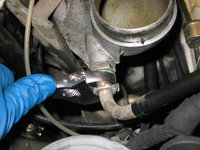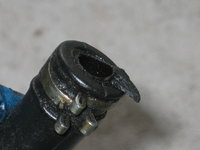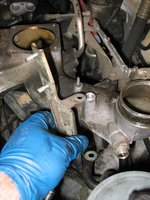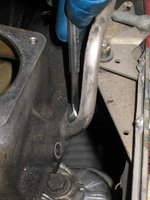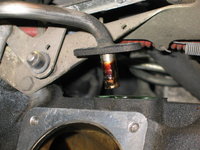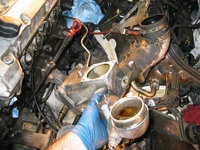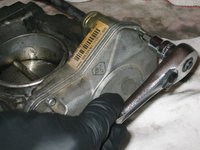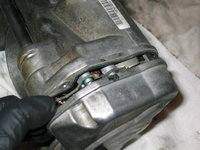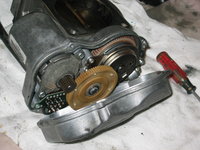Well, this afternoon I finally got started on my long-awaited top-end rebuild project, for my wife's 1995 E320 wagon. The symptoms that precipitated this rebuild are the following:
The car currently has almost 202,000 miles on the odometer, and the engine runs excellently, with plenty of power.
This is my first time doing major rebuild work on the engine of this car. In the past I've replaced the starter, alternator, motor mounts, coil packs, neutral safety switches, and things like that, but never major mechanical surgery. Thus, as with my M117 project this will be a big learning experience for me, and I am looking forward to it.
I expect the project to take 4-6 weeks, depending on the speed at which I am able to tear down the engine, as well as the speed of the machine shop and ETA remanufacturing shop in finishing those respective jobs. The car will have all soft parts underhood basically replaced, including all rubber, plastic, hoses, vacuum lines, connectors, seals, and so forth.
So, after arranging my garage to maximize workspace at the front of the car, and moving my cars around so that the E320 will use the middle of the garage (the most versatile position as I can move my cars and motorcycle parked on either side of the car to make additional room to work, if so required), and pulling the car up on ramps, it was ready to commence the job.
Here is the results of the first day's work. It was only about 2 hours, working slowly and taking my time. Basically I removed things from the top and front of the engine, and removed the battery and engine computers to release the end of the wiring harness. With the exception of a couple of connections, the wiring harness is basically about ready to be removed from the car.
Here's the process I followed, for this first day's work.
First off, here's an "overview" look at the M104.992 engine as it appears when I began the job.

As I was getting started, the mailman came, and I got a little package in the mail that made me smile ... a present from the Jack-Man (Jackasic), along with a couple of Feind Motorsports stickers. One of them promptly found its way onto the side of my toolbox....

The first thing to do, was to disconnect the battery. I did this by removing the negative terminal with a curved, 13mm box-end wrench, and then wrapped the terminal in several layers of a rag and rested it against the top of the battery. This keeps it handy in case I need to briefly reconnect it to power something on the car.


The next thing was to begin removing the intake tubing. To do this, I removed the MAF plug (rotating the knurled knob) and set it aside, and then removed the two clips that hold the air filter box to the end of the MAF.



Next step is to remove the two nuts that hold the intake tube to the top of the cam cover. These are quickly dispatched, and then the intake air temperature sensor (which is shared with the M119, and is a very cheap part) is removed from its hole in the intake crossover tube. I will replace this sensor when re-installing everything.
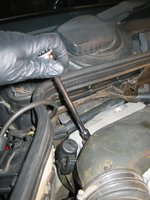

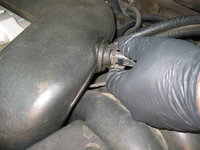
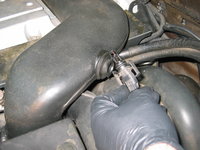
Then I loosened the MAF from the tube leading into the air filter box. The entire MAF/intake tube assembly is then swiveled a bit (loosening the ring clamp at the ETA may be necessary) and lifted upward, and off the top of the engine.
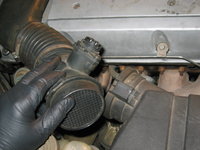


This is what the engine looks like, with the intake tube off.

In the process of removing the intake crossover tube and MAF, I noticed that the center cladding piece (center of the inner firewall) and its insulation was all broken apart, and the plastic retaining piece for the wiring harness leads was also broken into two pieces. This is likely because of engine heat. You can see the carnage in the photos below. Add these two pieces to the tally of parts that will need to be ordered and installed upon reassembly. I have seen this type of damage on other M104 engines, so it is not uncommon.



Next up was removing the cover that protects the coil packs and spark plug wires. This is held on by six 5mm Allen-head bolts, which are easily taken care of.

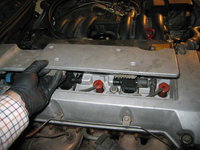
Upon opening the center compartment, the coil packs and wires are easily exposed. Here you can see the one remaining original-equipment MB coil pack, with the blue label. The other two are Bosch units (made in Slovenia) that I have replaced over the past couple of years. When I reassemble the engine, I will order a new coil pack and will install it too, and keep the blue-label pack as a reserve part.
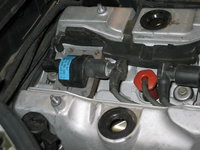


About this time, my wife brought me out a steaming-hot cup of coffee ..... which was much appreciated !!

Next up, time to attack the front of the motor. After removing the black plastic front cover, you can see the grit and grime covering the cam solenoid and other items in that area. Evidence of a nearby leak....

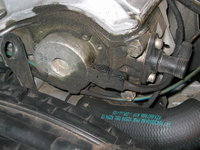
I removed the black plastic intake air director that sits immediately behind the passenger side headlight (very similar to the one used on the E500E. Air from this director goes directly into the air filter box via this tube. Notice the partially disintegrated foam seal around the intake tube. Another "soft" part that goes onto the next parts order....

One bolt later, and the mounting bracket for the air box removed, and it's time to lift out the entire air filter box....



This is what the airbox area looks like, with the airbox removed.

- a couple of small, persistent oil leaks from the head gasket
- a moderate leak at the front timing cover
The car currently has almost 202,000 miles on the odometer, and the engine runs excellently, with plenty of power.
This is my first time doing major rebuild work on the engine of this car. In the past I've replaced the starter, alternator, motor mounts, coil packs, neutral safety switches, and things like that, but never major mechanical surgery. Thus, as with my M117 project this will be a big learning experience for me, and I am looking forward to it.
I expect the project to take 4-6 weeks, depending on the speed at which I am able to tear down the engine, as well as the speed of the machine shop and ETA remanufacturing shop in finishing those respective jobs. The car will have all soft parts underhood basically replaced, including all rubber, plastic, hoses, vacuum lines, connectors, seals, and so forth.
So, after arranging my garage to maximize workspace at the front of the car, and moving my cars around so that the E320 will use the middle of the garage (the most versatile position as I can move my cars and motorcycle parked on either side of the car to make additional room to work, if so required), and pulling the car up on ramps, it was ready to commence the job.
Here is the results of the first day's work. It was only about 2 hours, working slowly and taking my time. Basically I removed things from the top and front of the engine, and removed the battery and engine computers to release the end of the wiring harness. With the exception of a couple of connections, the wiring harness is basically about ready to be removed from the car.
Here's the process I followed, for this first day's work.
First off, here's an "overview" look at the M104.992 engine as it appears when I began the job.

As I was getting started, the mailman came, and I got a little package in the mail that made me smile ... a present from the Jack-Man (Jackasic), along with a couple of Feind Motorsports stickers. One of them promptly found its way onto the side of my toolbox....

The first thing to do, was to disconnect the battery. I did this by removing the negative terminal with a curved, 13mm box-end wrench, and then wrapped the terminal in several layers of a rag and rested it against the top of the battery. This keeps it handy in case I need to briefly reconnect it to power something on the car.


The next thing was to begin removing the intake tubing. To do this, I removed the MAF plug (rotating the knurled knob) and set it aside, and then removed the two clips that hold the air filter box to the end of the MAF.



Next step is to remove the two nuts that hold the intake tube to the top of the cam cover. These are quickly dispatched, and then the intake air temperature sensor (which is shared with the M119, and is a very cheap part) is removed from its hole in the intake crossover tube. I will replace this sensor when re-installing everything.




Then I loosened the MAF from the tube leading into the air filter box. The entire MAF/intake tube assembly is then swiveled a bit (loosening the ring clamp at the ETA may be necessary) and lifted upward, and off the top of the engine.



This is what the engine looks like, with the intake tube off.

In the process of removing the intake crossover tube and MAF, I noticed that the center cladding piece (center of the inner firewall) and its insulation was all broken apart, and the plastic retaining piece for the wiring harness leads was also broken into two pieces. This is likely because of engine heat. You can see the carnage in the photos below. Add these two pieces to the tally of parts that will need to be ordered and installed upon reassembly. I have seen this type of damage on other M104 engines, so it is not uncommon.



Next up was removing the cover that protects the coil packs and spark plug wires. This is held on by six 5mm Allen-head bolts, which are easily taken care of.


Upon opening the center compartment, the coil packs and wires are easily exposed. Here you can see the one remaining original-equipment MB coil pack, with the blue label. The other two are Bosch units (made in Slovenia) that I have replaced over the past couple of years. When I reassemble the engine, I will order a new coil pack and will install it too, and keep the blue-label pack as a reserve part.



About this time, my wife brought me out a steaming-hot cup of coffee ..... which was much appreciated !!

Next up, time to attack the front of the motor. After removing the black plastic front cover, you can see the grit and grime covering the cam solenoid and other items in that area. Evidence of a nearby leak....


I removed the black plastic intake air director that sits immediately behind the passenger side headlight (very similar to the one used on the E500E. Air from this director goes directly into the air filter box via this tube. Notice the partially disintegrated foam seal around the intake tube. Another "soft" part that goes onto the next parts order....

One bolt later, and the mounting bracket for the air box removed, and it's time to lift out the entire air filter box....



This is what the airbox area looks like, with the airbox removed.

Last edited by a moderator:

















